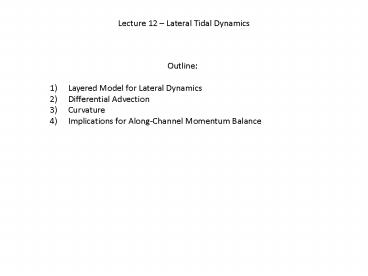Lecture 12 Lateral Tidal Dynamics - PowerPoint PPT Presentation
1 / 21
Title:
Lecture 12 Lateral Tidal Dynamics
Description:
Differential Advection. Curvature. Implications for Along-Channel Momentum Balance ... Differential Advection Leads to an Axial Convergence Front (Nunes ... – PowerPoint PPT presentation
Number of Views:101
Avg rating:3.0/5.0
Title: Lecture 12 Lateral Tidal Dynamics
1
Lecture 12 Lateral Tidal Dynamics
- Outline
- Layered Model for Lateral Dynamics
- Differential Advection
- Curvature
- Implications for Along-Channel Momentum Balance
2
Ekman Transport is to the left of the overlying
along-channel flow
z
??
?
?o
Ekman Transport
Looking up-estuary, flow into estuary (flood)
3
Layered (Reduced Gravity) Models
See Cushman-Roisin Intro to GFD for more info.
- For stable stratification, density increase
monotonically with depth. - If density is conserved by individual fluid
parcels, you can transform the equations from a
coordinate system based on z to a coordinate
system based on density. - Define reduced gravity (g) as
?
?z
??
? ??
?x
Baroclinic Pressure Gradient can represented as
the slope of the density interface multiplied by
the reduced gravity
4
Simple Reduced Gravity Model for Tidal, Lateral
Dynamics
What is the 1st order x-momentum balance in
surface layer?
5
Simple Reduced Gravity Model for Tidal, Lateral
Dynamics
What is the 1st order x-momentum balance in
surface layer?
Assume that both u1 and surface slope have
periodic solutions
6
What is the 1st order x-momentum balance in
bottom layer?
R is linear drag coefficient 110-4
Again, look for periodic solutions
Bottom drag reduces lower layer current and
reduces phase relative to surface layer.
7
What is the 1st order lateral momentum balance?
Surface layer
Bottom layer
From previous slide
From previous slide
Plug in expressions for u2 and d?/dy
Integrate in y
Continuity Equation
Plug in expressions for ?o and integrate in y.
Apply BCs that v 0 at y0 and yL gives
solutions for V and ?..
8
Simple Reduced Gravity Model for Tidal, Lateral
Dynamics
Governing Equations
Solution
Upper Layer
Lower Layer
x-momentum
y-momentum
continuity
where g g????
assume periodic solutions (u,v,?,? ei?t)
9
Observations from the York River
a) Depth-integrated Lateral Momentum Balance
1.0
coriolis
P.G.
0.5
0
Pa
-0.5
-1.0
Dec-7
Dec-14
Dec-21
Dec-28
Jan-04
Jan-11
b) Depth-integ. Momentum Balance
c) Tidal cycle momentum balance
0.4
0.6
r 0.75
coriolis
baroclinic P.G.
0.4
0.2
0.2
0
0
Pa
Pressure Gradient (Pa)
-0.2
-0.2
barotropic P.G.
-0.4
-0.4
-0.6
0
0.4
0.2
-0.2
-0.4
-0.6
0.6
EBB
FLOOD
Coriolis (Pa)
10
Comparison of Momentum Balance--Model vs.
Observations
Phase Averaged
Lateral Momentum Balance from Observations
0.4
barotropic P.G.
0.2
coriolis
0
Pa
baroclinic P.G.
-0.2
-0.4
EBB
FLOOD
Lateral Momentum Balance from Lower Layer of
Reduced Gravity Model
0.4
barotropic P.G.
coriolis
0.2
0
Pa
baroclinic P.G.
-0.2
-0.4
EBB
FLOOD
11
Phase Averaged Salinity Data from the York River
12
Reduced Gravity (Layered) Models Assumes Invisid
Surface Layer
What are Lateral Dynamics Under Well-Mixed
Conditions
Tidal Differential Advection
Lateral Circulation
Fresher
Fresher
Saltier
Flood
(Nunes Simpson, 1985)
Ebb
(from Smith, 1996)
13
Differential Advection Leads to an Axial
Convergence Front
(Nunes Simpson, 1985)
Assumed balance
Sideways estuarine circulation
14
Channel Curvature
Along-Channel Flow
Outer Bank
Inner Bank
Tilted Surface
Secondary Flow
15
Forcing of Secondary Flow by Channel Curvature
Using curvilinear coordinate system
Stream-wise
R radius of curvature
Stream-normal
advection of secondary flow
coriolis
acceleration
friction
Pressure Gradient
centrifugal
(us,un) along-channel, cross-channel
currents (s,n) along-channel, cross-channel
directions R radius of curvature (positive
if outer bank is in positive
y-direction)
s
n
16
Simple Steady Stream-wise Momentum
Balance Constant eddy viscosity, Az
Integrate twice and apply BCs us 0 at z -H
and dus/dz 0 at z 0
Depth
us(z)
us(z)
17
Simple Stream-normal Momentum Balance
Assume 1) steady (no dun/dt) 2) no
rotation (f 0) 3) no stream-wise
advection of secondary flow. 4)
Homogenous (no baroclinic PG) 5)
Constant Az
Boundary conditions
1) un 0 at z -H, 2) dun/dz 0 at z 0 3)
vertically averaged un 0
Using solution for us from previous slide
Depth
us(z)
un(z)
18
Scale for Curvature-Forced Secondary
Circulation Homogeneous Fluid! Geyer, 1993, JGR,
98955-966. Kalkwijk and Booij, 1986, J. Hydraul.
Eng., 2419-37.
U0 Amplitude of tidal current
? Karmans constant (0.41)
19
Rotation and Secondary Circulation
Cross-channel momentum equation with rotation
(but still homogenous)
Vertical-average (assume ?vdz 0)
Subtract mean equation from time varying
Curvature forcing
Rotation forcing
20
Relative Importance of Curvature and Rotation
in Driving Secondary Flows
Curvature Rossby Number
using
Curvature and rotation both important (R01) when
R5-10 km
(f 1x10-4 s-1 and u0 1 m/s)
21
Secondary Flows are Important because they
re-distribute mass and momentum. Act like large
scale turbulence. They play a key role in tidal
dispersion as well as the along-channel momentum
balance
For Next Week we will discuss the following 2
Papers
Lerczak, J. A., and W. R. Geyer, 2004 Modeling
the lateral circulation in straight, stratified
estuaries. J. Phys. Oceanogr., 34,
1410-1428. Geyer, W. R., J. H. Trowbridge, and
M. M. Bowen, 2000 The dynamics of a
partially-mixed estuary. J. Phys. Oceanogr., 30,
2035-2048.
I will email them to you, please be prepared to
discuss them.































